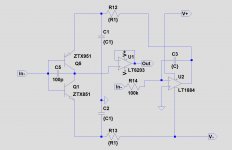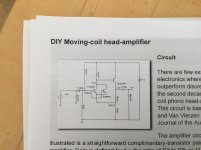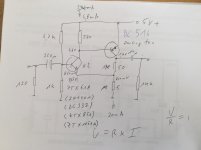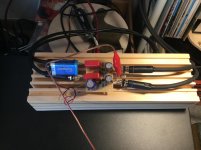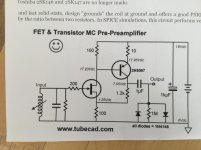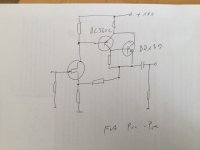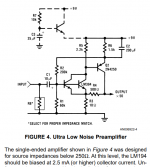I have used this John Curl design successfully in another thread.No, but there are lot of Zetex transistors that are useful for this purpose.
Here is the most simple circuit I could think of.
It is a John Curl design from the 70th.
You could also take out the feedback resistor and terminate the output with it.
You could call the first version shunt feedback and the second version a kind of Lokal current feedback. Some will say open loop.
Two op-amps where added: one to take the output impedance of both transistors out of the equation, making that a very low value for the feedback resistor can be used.
The second op-amp to keep the input voltage within a few uV, preventing any current to flow into the Cart and at the same time removing the need to match the Vbe of the transistors.
Noise RTI of this solution is in the order of 220pV/rtHz, and sound reproduction is fantastic.
Hans
Attachments
So the feedback resistor can be added between Out and In - ?
U2 supplies the current, in my case 3mA.
Feedback resistor goes from Out to In-.
In case of using it as a transimpedance amp, this feedback resistor can be as low as 20 Ohm without any problem, depending on the Cart used and the Gain that’s needed.
Hans
Cool , thanks
Maybe you can use some of this idea, I don't want to intrude any further into your thread.
Hans
R12 = R13 = 301R.
V- = -1.5 Volt
V+ = +2.1 Volt
Hans
Why would you want to use unequal and low supply voltages like this ?
The servo function can be performed with regular supply as well (little
change of wiring) and input stage bias by adjusting R12, R13 accordingly.
I do not fully understand what you mean, but the supply in my case is either a floating 5V 10Ah powerbank for smart phones or a floating 5V 5Watt USB adapterWhy would you want to use unequal and low supply voltages like this ?
The servo function can be performed with regular supply as well (little
change of wiring) and input stage bias by adjusting R12, R13 accordingly.
The -1.5 volt comes from a LED and the 2.1V in series from a (LED+Diode), this being fed from the 5Volt. The connection between both Led’s is made to be the signal gnd.
The servo as used in this way does not add any to the excellent noise behaviour.
Hans
This is my version. I took 2 ZTX618 transistors in parallel that have lower noise then the 2N4401. The second transistor is a Darlington. One effect of this is that the idle current in the input stage is approximately doubled to a value of 5mA. I lowered the resistor values in the feedback also in an attempt to lower the noise contribution of the 10Ohm resistor.
The result is a very quiet Pre-Pre with decent bandwidth and low distortion. At 5mV input it should be less then 0,01% mainly second harmonic. The sound is very analog with some warmth. Resolution and dynamics are good too. As a beginner project it is ideal.
The result is a very quiet Pre-Pre with decent bandwidth and low distortion. At 5mV input it should be less then 0,01% mainly second harmonic. The sound is very analog with some warmth. Resolution and dynamics are good too. As a beginner project it is ideal.
Attachments
Here is a picture of my build. At the input is an electrolyte Cap. A good quality one should be used here. I took an Elna Silmik 2 that is optimized for low distortion.
It has the advantage that the cartridge sees very little DC voltage.
Some people may not like a coupling cap at the input. I show you a solution later how this can be avoided.
It has the advantage that the cartridge sees very little DC voltage.
Some people may not like a coupling cap at the input. I show you a solution later how this can be avoided.
Attachments
ztx1055 could be added on thet list, but i'm not really sure that the switching ZTX transistors are really good for this app because their high hfe is corelated with an equally high collector current...i have all of them 651, 751,851, 951,1051, 1055, but never used them yet...
Just for fun I build a version of the Nordholt - Vierzen MC Pre-Pre from the AES Journal April 1980.
I found this version in the picture on the net and modified it for lower noise and distortion.
Memories from 2009, remember? (National AN-222 Fig 4)
🙂
George
